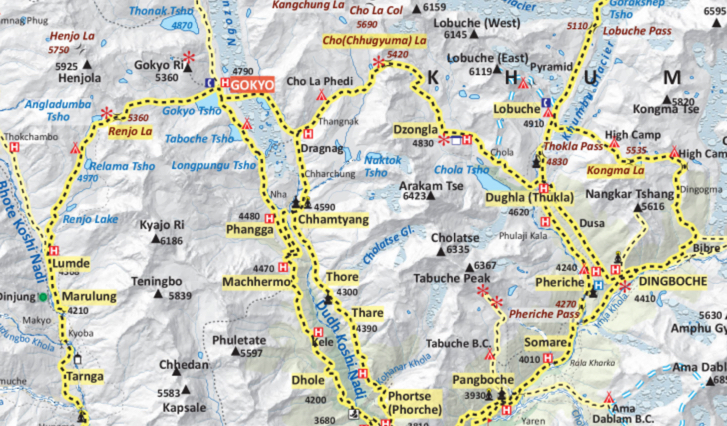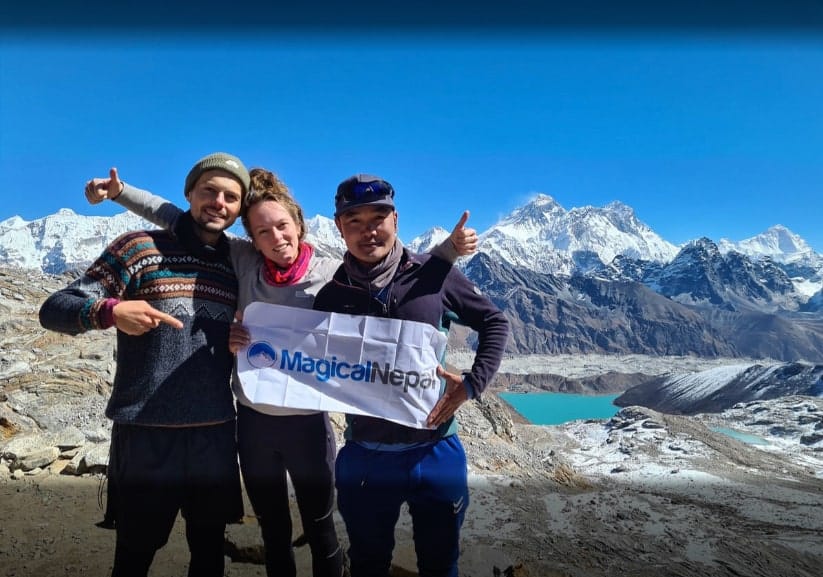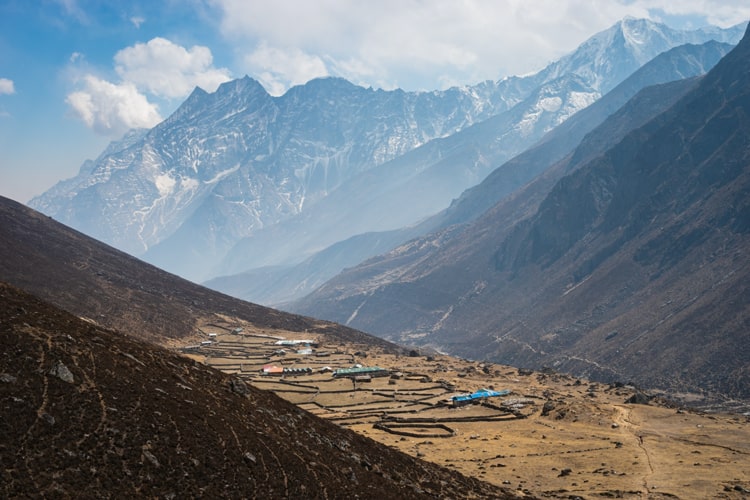Everest Three High Pass Trek
- Satisfied Client
- Personalised Guide
- Instant Response
Get Instant Response:
+977-9851329446 (Whatsapp)
| Starts at: Lukla | Ends at: Lukla |
| Trek Region: Everest | Transport: Flight |
| Duration: 18 Days | Trip Grade: Challenging |
| Max Altitude: 5,643 m / 18,513 ft (Kala Patthar) | Accommodation: Teahouse |
Everest Three High Pass Trek Highlights
- Cross three popular passes in the Everest region – Renjo La, Cho La, and Kongma La
- Explore the glacial lakes of the Gokyo Valley
- Have an adventurous yet, challenging time while crossing these passes
- Get a close insight into the life of the Himalayan Sherpa people
- Catch the finest views of Mt. Everest from Kala Patthar (5545 meters / 18,192 ft)
The Everest Three Pass Trek consists of crossing three high-altitude passes, namely, Renjo La Pass (5465 m), Cho La Pass (5420 m), and Khongma La Pass (5,535 m /18,159).
Here are some long days (9 hours) and strenuous accents, so a high level of fitness is required. The trek combines crossing these passes with the other ‘must-do’ areas of the Khumbu: Everest Base Camp, Namche Bazaar, Tengboche Monastery, and the Gokyo Lakes.
Flying in and out of Lukla, two routes are possible, clockwise and anti-clockwise. But both routes provide you with the same terrain and spectacular views.
This trek is the definitive Everest region trek for the adventure-seeking trekker!
Here is just a taste of what to expect from this trek:
From the top of the Renjo La Pass (5,464m /17,926), the views of Everest reportedly beat even the panoramic Everest views from Kalapatthar. There are also spectacular views of Gokyo Lake.
Cho La Pass (5,420m /17,782 ft) is formed between the snowcapped summits of Lobuche (6,135m /20,127 ft) and Cholatse (6,443m). The steep climb is challenging and icy in parts, but from the summit, there are spectacular views of Ama Dablam.
Kongma La Pass has been described as more of a ‘precarious struggle among skittering stones.’ The route takes you across a glacier, and glacier-fed river, and the climb up to the pass at 5,535m /18,159 ft is the highest on this trip.
You can regain your breath as you take in the views from the top of the pass where Lhotse and Makula feel their presence and the view of the turquoise lakes below contrasts the majesty of the mountains.
As mentioned, this trek takes in not just the three passes but also a trip up Kalapatthar, the famous place to view Mount Everest (in fact, it is often referred to as the Everest View Point), and a trek to Gorak Shep and Everest Base Camp.
The names of which are very familiar to anyone who has an interest in the Everest region or knows something about the history of Mount Everest.
Two other highlights of this trek are Tengboche Monastery, the highest monastery in the Khumbu Region, and the Gokyo Lakes, the highest freshwater bodies in Nepal. If you want to explore three passes but don’t want to trek, check out the Everest Helicopter tour, which is the best way to see these places without trekking.
Everest Three Pass Trek Itinerary
Day 1: Arrival in Kathmandu
Kathmandu – 1,300 m / 4,265 ft
Day 2: Kathmandu to Lukla (Flight) to Phakding
Phakding – 2,651 m / 8,697 ft – 3 to 4 hrs
Day 3: Phakding to Namche Bazaar
Namche Bazaar – 3,438 m / 11,279 ft – 5 to 6 hrs
Day 4: Acclimatization day
Namche Bazaar – 3,438 m / 11,279 ft – 5 to 6 hrs
Day 5: Namche to Tengboche
Tengboche – 3,956 m / 12,979 ft – 5 to 6 hrs
Day 6: Tengboche to Dingboche
Dingboche – 4,380 m / 14,370 ft – 4 to 5 hrs
Day 7: Acclimatization Day in Dingboche
Dingboche – 4,380 m / 14,370 ft – 3 to 4 hrs
Day 8: Dingboche to Lobuche via Khong Ma La Pass
Lobuche – 4,938 m / 16,200 ft – 10 hrs
Day 9: Lobuche to Gorakshep (Afternoon hike to Kalapatthar)
Gorakshep – 5,368 m / 17,611- 8 hrs
Day 10: Gorakshep to Dzongla (Morning hike to EBC)
Dzongla – 4,830m / 15,846 ft – 8 hrs
Day 11: Dzongla to Gokyo via Cho La Pass
Gokyo – 4,800 m / 15,748 ft – 8 to 9 hrs
Day 12: Acclimatization day
Gokyo – 4,800 m / 15,748 ft
Day 13: Gokyo Valley to Marlung via Renjo La Pass
Marlung – 4,210 m / 13,812 ft – 7 to 8 hrs
Day 14: Marlung to Namche Bazaar
Namche Bazaar – 3,438 m / 11,279 ft- 5 to 6 hrs
Day 15: Namche Bazaar to Lukla
Lukla – 2,860 m / 9,383 ft – 7 – 8 hrs
Day 16: Lukla to Kathmandu (Flight)
Lukla – 1,400 m / 4,593 ft – 35 minute
Day 17: Departure
Departure
Day 1: Arrival in Kathmandu
- Accommodation: Hotel
We will pick you up at the airport and transfer you to your hotel where we will brief you on your upcoming trek. Feel free to explore the surrounding area today or catch up on your sleep before your early morning flight.
Day 2: Kathmandu to Lukla (Flight) to Phakding
- Flight time: 35 to 40 minutes
- Trek time: 3 to 4 hours
- Accommodation: Tea House
Wake up early for an amazing mountain-filled flight into one of the highest airports in the world! After meeting your local crew and being awed by the airstrip you just landed on, set off on a trail that takes you past a monastery, over a suspension bridge, and into the heartland of the Sherpa people.
We stop for the first night at Phakding, about a 3 hour’s hike from Lukla.
Day 3: Phakding to Namche Bazaar
- Trek time: 5 to 6 hours
- Accommodation: Tea House
After breakfast start trekking with both ascents and descents to reach the market town of Namche Bazaar. The trail takes us to the entrance of Sagarmatha National Park, over some more suspension bridges, and through rhododendron forests.
Tonight we sleep in the biggest Sherpa town in the region – bustling with trekkers and climbers and locals going about their business.
Day 4: Acclimatization Day in Namche Bazaar
- Trek time: 5 to 6 hours
- Accommodation: Tea House
Today is a day to let the body acclimatize as we have risen quickly to this altitude. The best way to acclimatize is to be active. Either be exploring Namche or better still, taking a walk in the neighborhood. Head for the Everest View Hotel for your morning coffee! You might come across people who have helicoptered in for breakfast with a view! And what a view it is – majestic Mt. Everest as the name suggests.
You might want to continue on to Khumjung village, home to Khunde Hospital and Khumjung School. Both were built in the 1960s by Sir Edmund Hillary. Here you also find Khumjung Monastery which dates back hundreds of years although was reconstructed after the 2015 earthquake. Today, as in the past, it is the center of Sherpa’s religion and culture. Allegedly there is a Yeti scalp inside the monastery!
Finally, stock up on any snacks you might want to take with you – the last shopping opportunity of the trek!
Day 5: Namche to Tengboche
- Trek time: 5 to 6 hours
- Accommodation: Tea House
Tengboche village is home to Tengboche monastery, which boasts some of the most spectacular views of Everest and Lhotse! The route heads out across the Dudh Koshi River and through thick forests which gradually thin out as you cross the tree line. As this is a Buddhist monastery there are stupas and mani (prayer) walls along the way.
There is an opportunity to attend prayers with the monks as well as take in the astounding views before retiring for the night in the village.
Day 6: Tengboche to Dingboche
- Trek time: 4 to 5 hours
- Accommodation: Tea House
The trail is rugged and there are few trees on this windy trail between Tengboche and Dingboche villages. With Ama Dablam towering above, the trail enters the Imja Valley where it descends to the Lobuche River before rising steeply up to Dingboche.
This lovely village has fields surrounded by stone walls to protect the high-altitude crops from grazing animals and the wind. And quite a few lodges!
Day 7: Acclimatization Day in Dingboche
- Trek time: 4 to 5 hours
- Accommodation: Tea House
Another acclimatization day to aid with the rise in altitude and once again we suggest you keep active! What better way to spend the time than by hiking to a viewpoint at Nagarjune Hill (5,100m) – a round trip of around 4 to 5 hours. The views are, naturally, worth the effort! Periche Valley lies below and above lies Ama Dablam, Thamserku, Lobuche East and Lobuche West, among others.
Day 8: Dingboche to Lobuche via Khong Ma La Pass
- Trek time: 10 hours
- Accommodation: Tea House
It’s a long day for sure, but a memorable and adventurous one too. The trail starts steeply to climb out of the valley to Dugla, located at the end of the terminal moraine of the Khumbu Glacier then onto Chukpo Lari. Here we find memorials to climbers who have died on Everest – placed here in memory with a panorama of beloved mountains on the Nepal-Tibet border.
Today we cross the challenging Kongma La Pass (5, 545m) with views of many peaks such as Lobuche, Mehra, the south face of Nuptse, and many others which your guide will be happy to point out to you. The high altitude crossing the pass is the reason we take acclimatization days beforehand.
Day 9: Lobuche to Gorakshep (Afternoon hike to Kala Patthar)
- Trek time: 7 to 8 hours
- Accommodation: Tea House
The trail from Lobuche rises slowly and over a period of 3 hours to Gorakshep. After checking into the lodge at Gorakshep and having lunch, we set off to hike to Kala Patthar, otherwise known as the Everest viewpoint.
Although Everest Base Camp is a very popular destination – and one we will explore the following day – Kala Patthar gets you closer to Everest than you can ever be without actually climbing the great mountain! Kala Patthar is a black rock (hence its name) with astounding views which are hard to comprehend until you are there.
After this spectacular adventure, return to Gorakshep for the night.
Day 10: Gorakshep to Dzongla (Morning hike to EBC)
- Trek time: 8 hours
- Accommodation: Tea House
On leaving Gorakshep in the early morning we hike along the Khumbu Glacier to Everest Base Camp. This iconic location is actually different from the one climbing expeditions use. But we can see their colourful tents nearby – but far enough away that trekkers do not disturb them in their arduous preparations.
Returning to Gorakshep for breakfast we then set out for Dzongla where we stay overnight.
Day 11: Dzongla to Gokyo via Cho La Pass
- Trek time: 8 to 9 hours
- Accommodation: Tea House
Another early start as we head towards the Cho La Pass with its glacier and stunning views. The trail starts off easy enough before a steady ascent. But the views of Ama Dablam, among other mountains, rivers, and glaciers are simply at their best. The terrain of loose rocks makes the going slow until you reach the start of the glacier. Crampons are really required here (buy or rent in Thamel, Kathmandu before you start your trek). In the distance that turquoise lake comes back into view.
Again the elevation increases as we climb up the pass. At the top, under the fluttering prayer flags, take a bit of a rest and gather some great photos!
Coming down over the pass head for the village of Thagnak for lunch before crossing another glacier and onwards to Gokyo where we stay overnight.
Day 12: Acclimatization day
- Accommodation: Tea House
We take another acclimatization day here at Gokyo – an opportunity to explore this village and the surrounding area.
Day 13: Gokyo Valley to Marlung via Renjo La Pass
- Trek time: 7 to 8 hours
- Accommodation: Tea House
Heading off early we follow the peaks of Everest, Cholatse, Lhotse, and more down some stone steps and on through a narrow valley, passing Renjo Lake and walking alongside Dudh Pokhari (lake).
The trail over the Renjo La Pass takes in views of the third Gokyo Lake and Gokyo village along with Ngozumpa Glacier. And of Mount Everest is there in all its glory! The lakes of Relama Tsho and Renjo are seen on the way too as you make your way down to Marlung situated on the bank of the Bhote Koshi River.
Day 14: Marlung to Namche Bazaar
- Trek time: 5 to 6 hours
- Accommodation: Tea House
Today the end of the trek is in sight, so enjoy the stunning views while you can. Descend into Thame village and cross the Bhote Koshi River before heading on downwards and crossing a couple of bridges to reach Thame. The village has its own gompa (monastery) situated on a hill above it. The trail continues to descend until you reach Namche Bazaar.
Day 15: Namche Bazaar to Lukla
- Trek time: 7 to 8 hours
- Accommodation: Tea House
Today we follow the Dudh Koshi River to Lukla where we overnighted waiting for the flight back to Kathmandu.
Day 16: Lukla to Kathmandu
- Flight time: 35 to 40 minutes
- Accommodation: Hotel
Once again the flight is one you will not forget! Mountains and farmland lie all around until finally, we reach the city of Kathmandu. We will escort you to your hotel and give you the tips you want on how to spend the rest of your day.
Day 17: Departure
We will ensure you reach the airport on time for your onward flight. If you are not leaving the country, do ask us about other adventures we can arrange for you.
Not satisfied with this Itinerary?
Are you interested on planning custom trip? It only takes 2 minutes.
Includes
- Local transfers for your international flight x 2 (arrival/departure)
- Local transfers for your domestic flight x 2
- Kathmandu Lukla Kathmandu Flight
- Sagarmatha National Park Entry Permit and Local Entry Permits
- Guide for 16 days
- Porter for 15 days
- 2 nights accommodation in a Kathmandu hotel (Norbulinka boutique hotel or similar)
- 15 night accommodation in mountain teahouses
- Staff insurance and necessary ground transport for support staff
- 16 x set breakfast, 15 x set lunch and 15 x set dinner while on trek.
- Lunch and dinner in Kathmandu
- Personnel expenses of any kind and travel insurance
Everest Three High Pass Trek Map

Related Trips in Everest Region
Everest View Trek | Gokyo Lake Trek | Gokyo Chola Pass EBC Trek | Everest Base Camp Trek | Jiri To Everest Base Camp Trek | Island Peak Climbing | Lobuche Peak Climbing | Mera And Island Peak Climbing | Mera Peak Climbing | Baruntse Expedition | Everest Helicopter Tour

